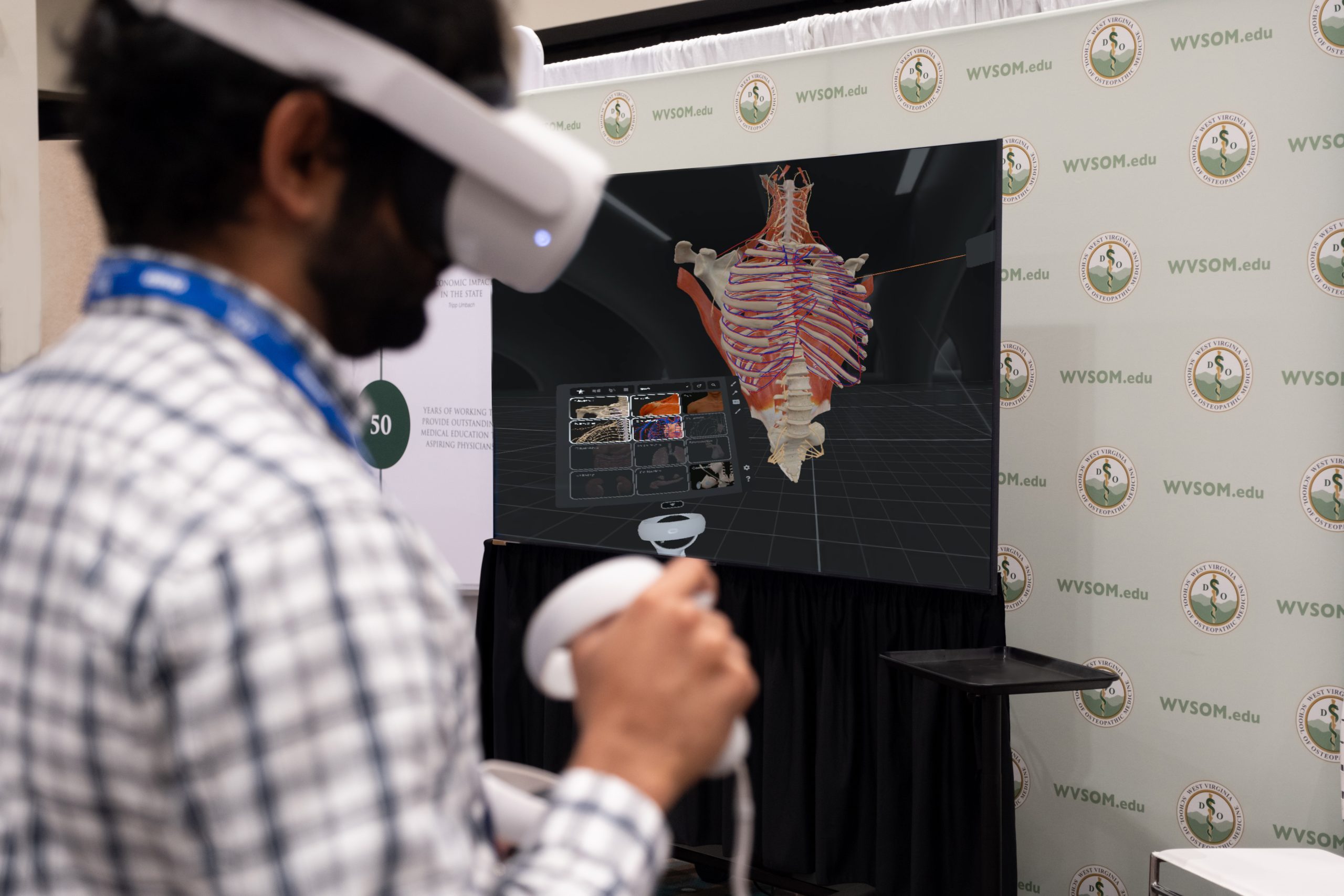
Two years ago, the West Virginia School of Osteopathic Medicine (WVSOM) began rolling out virtual reality clinical scenarios as additional educational tools for its students. Now, the institution is offering students another virtual reality component – anatomy.
Medical students are once again using headsets and hand controllers, this time to immerse themselves in anatomical simulations to test the technology.
“Our students, when given the opportunity to self-select, have found virtual reality to be valuable because it’s a different way to visualize material they would often only see on a two-dimensional sheet of paper. It’s a different way to experience anatomy,” said Katie Williams, Ph.D., WVSOM’s director of academic technology and support.
The technology was introduced to WVSOM’s first-year students in August 2023, with technology testing taking place throughout the fall semester. It began again in the spring semester before determining how it will be incorporated into WVSOM’s new Finding Health Curriculum, to be implemented in July.
“Right now we are in the testing phase to figure out if we want to incorporate it into the curriculum – is it something that is mandatory during lab or is it a support tool?” Williams said. “We need to determine how it is best adopted. What is the best technique for student performance and how will it increase student performance?”
The anatomy virtual reality technology is provided by a company called BodyMap and the headsets and controllers are from Meta Quest. WVSOM has 22 headsets for anatomy virtual reality, with four designated as instructor sets. Williams operates the technology for 16 students in 30-minute sessions.
Unlike virtual reality clinical scenarios, which are more team-based experiences, the BodyMap technology allows students to independently focus on different areas of the body. For example, a student can enlarge the nerves when exploring the musculoskeletal system or hone in on the right shoulder when studying upper limbs. The technology also allows students to understand how systems interact with each other.
Dina Mohamed-Aly, of WVSOM’s Class of 2026, has acquainted herself with the anatomy technology. Mohamed-Aly is the only WVSOM work-study student tasked with providing student feedback on how to integrate anatomy virtual reality technology into medical education.
“I think virtual reality is a good study aid. If you are in the course and looking at specific parts of the body, you can really master those areas. It can be helpful because you have the entire body map and you can move things around,” Mohamed-Aly said. “It’s like when you’re dissecting, but you can remove a muscle or visualize the 3D layers of the body more easily without getting into scrubs and going into the lab. It’s low stakes, but it’s also very realistic.”
Williams said the incorporation of an anatomy student assistant was deliberate and has been invaluable.
“Dina has an interesting and unique role that not a lot of students have, and it’s not something I’ve seen in any of the literature about curriculum development,” she said. “She is someone who has pre-existing knowledge of problem areas that she and other members of her cohort have experienced. She’s giving feedback to the program creators as well. Prioritizing student feedback is a powerful component of the technology.”
One recommendation Mohamed-Aly has provided is to include prosection images in the headsets. Prosections are cadaver dissections completed by the anatomy department that are used as models for students to learn from and identify features they might not have been able to dissect at their lab station. Incorporating real-life images in simulations would provide up-close viewing without having to wear down a physical cadaver.
“It feels great to be able to contribute to the improvement of this technology for WVSOM students,” Mohamed-Aly said. “The faculty value my feedback as a student because they want to know what I’m encountering and how helpful it is to me so they know how much to invest in this program.”
Five additional WVSOM faculty members have been part of the anatomy virtual world: Kristie Bridges, Ph.D., Courtney Eleazer, Ph.D., Rebecca Scopa Kelso, Ph.D., Irene Smail, Ph.D., and Peter Ward, Ph.D.
Even though details of how anatomy virtual reality will be included in WVSOM’s new curriculum are still being determined, Williams said this technological tool is here to stay.
“Medical school applicants are more aware of this type of technology being used in curricula now – whether it’s supplemental or embedded in the curriculum and a graded element,” she said. “Students have an expectation of top-of-the-line technologies, and this is one of them.”

